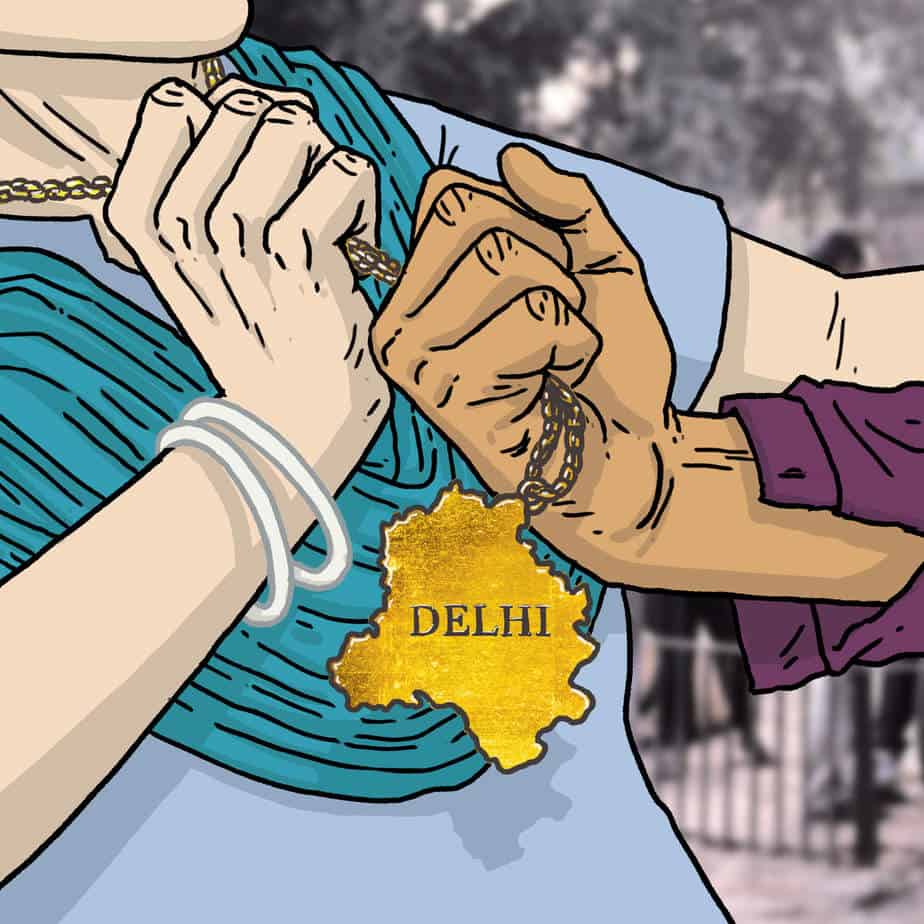With over 8,000 cases in 2017, incidents of snatching continue to torment the lives of Delhiites, and give major headaches to Delhi Police
It was 10:30 in the morning. Ruma Ganguly was walking towards her daughter’s school in Mayur Vihar for a parent-teacher meeting. Engrossed in talking to her daughter, she did not even have the time to react when two men on a bike snatched her chain and fled.
Ruma is among the thousands of victims of snatchings in the city. “I did not file an FIR, as such cases happen here in Mayur Vihar every day and nothing much is done about it,” she says. An old lady living in her complex had her bag snatched at gunpoint in broad daylight a few months back.
According to the statistics obtained from Delhi Police, there have been 8,231 cases of snatching in 2017 and 2,110 cases that have already been reported till April 30 this year. So, there have been 18 cases of snatching per day, which means that a new case of snatching is reported every 75 minutes.
The number of cases too have seen a vast increase in the past few years. The period 2013-17 saw a total of 38,686 cases whereas there have been 7,309 cases in 2008-12. Thus, the number of crimes have increased by more than five times.
While the police department blames the population of Delhi for the rise in the number of cases, statistics prove otherwise. While Delhi is the most populated city with 1.6 crore inhabitants, Mumbai comes second with 1.2 crore. But while Delhi experienced more than 8,000 snatchings in 2017, Mumbai witnessed only 200. So, the number of cases in Delhi is over 40 times more than that of Mumbai, though the population of the capital is only 1.3 times more when compared with Mumbai.
Lipi Vats was returning to office at 9:30 in the night to collect the keys she left behind, when she became another victim of snatching. Last December, on her way back, she stopped at an ATM in South Extension to take cash when she saw two men on bikes watching her. On coming out, she didn’t see them again. After 10 minutes, just when her auto was about to reach office, two men on a bike without number plates snatched her bag and fled. She called up the police and they reached the spot in few minutes, following which she filed an FIR. The next time she heard from them was after five months, when they called her to appear in court to close the case as there was no lead.

However, not all received even this much of co-operation from the police. In many instances, the police have tried to dissuade the victims from filing an FIR. In September 2017, Swagata was on her way to the Metro station in Mayur Vihar Phase 1 on a cycle rickshaw when a scooterist came from behind and tried to snatch her bag. She tried holding on to it and in the scuffle the rickshaw overturned, she fell on the road and her bag was torn. The snatcher fled with parts of the bag. Her torment did not end there. The police refused to file an FIR and she waited for more than an hour before they let her register a complaint. “They asked me why I wanted to file an FIR, since my bag had only R2,000 in it,” she says. They further told her that she was ‘lucky’ nothing worse happened.
The places that have been identified as the most snatching-prone areas are Prashant Vihar, Mayur Vihar, Dwarka and Rohini. East Delhi’s Mayur Vihar is identified as the most notorious part of the capital. An official at the Mayur Vihar police station says that five to six cases of snatching are reported on a daily basis there. “The area falls on the border of Delhi and Uttar Pradesh. So, it is easy for them to commit the crime and flee to Noida, where the jurisdiction of the Delhi Police ends,” says the official on the condition of anonymity. Inspector Jeet Singh, in contrast is in denial. He says Mayur Vihar has seen very few cases of snatchings.
The Crime in Delhi 2017 report published by Delhi Police shows that out of the 5,974 people arrested for snatching in 2017, 91.74% were first-time offenders, while 66.24% were illiterate or school dropouts. “Most of the criminals are unemployed and are trying to make a quick buck. They look for soft targets to carry out such crimes,” said Anil Mittal, PRO, Delhi Police. Even though the number of cases solved has increased by 21% when compared with that of 2016, only 55% of the total number of cases got solved in 2017.
The police website, on the other hand, instead of mentioning the steps taken to solve crimes or prevent snatchings, mentions ways in which the victim could prevent such crimes. It says, “A bag that dangles from the shoulder can be easily yanked off your shoulder by someone coming up from behind”. Wouldn’t that be how every woman carries her bag?
However, the Delhi Police do want some legal changes to curb the problem. They have proposed adding two sections, A and B, to Section 379 of the IPC to make the offence non -bailable. Anil Mittal adds that laws against snatching should be made more stringent and it should become a non-bailable offence as was done in Haryana. The neighbouring state recently made snatching non bailable and punishable upto 10 years of imprisonment.
The proposal is now being examined by the Delhi High Court. If it is passed then the authorities expect that there will be a drastic fall in the number of snatchings as criminals would be scared of the consequences, and the streets will be safer for people like Ruma, Lipi and Swagata.





